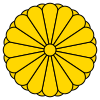
Fushimi-no-miya
Encyclopedia

Shinnoke
was the collective name for the four cadet branches of the Imperial Household of Japan, which were until 1947 entitled to provide a successor to the Chrysanthemum throne if the main line failed to produce an heir...
, branches of the Imperial Family of Japan
Japan
Japan is an island nation in East Asia. Located in the Pacific Ocean, it lies to the east of the Sea of Japan, China, North Korea, South Korea and Russia, stretching from the Sea of Okhotsk in the north to the East China Sea and Taiwan in the south...
which were eligible to succeed to the Chrysanthemum Throne
Chrysanthemum Throne
The is the English term used to identify the throne of the Emperor of Japan. The term can refer to very specific seating, such as the takamikura throne in the Shishin-den at Kyoto Imperial Palace....
in the event that the main line should die out.
The Fushimi-no-miya was founded by Prince Yoshihito, the son of the Northern Court Emperor Sukō
Emperor Suko
) was the third of Ashikaga Pretenders during the Period of the Northern and Southern Courts in Japan. According to pre-Meiji scholars, his reign spanned the years from 1348 through 1351.-Genealogy:...
. As the house was founded by a Northern Pretender, the first three princes are sometimes not recognized as legitimate Fushimi-no-miya Princes.
All of the much later ōke
Oke
The , were branches of the Japanese Imperial Family created from branches of the Fushimi-no-miya house. All but one of the ōke were formed by the descendants of Prince Fushimi Kuniye. The ōke were stripped of their membership in the Imperial Family by the American Occupation Authorities in...
were branches off of the Fushimi-no-miya house, all but one of them being created by sons of Fushimi-no-miya Kuniye.
Unless stated otherwise, each prince is the son of his predecessor.
| Name | Born | Succeeded | Resigned | Died | Notes |
| 1 |
Emperor Suko
) was the third of Ashikaga Pretenders during the Period of the Northern and Southern Courts in Japan. According to pre-Meiji scholars, his reign spanned the years from 1348 through 1351.-Genealogy:...
|-
| 2 || || 1370 || 1416 || . ||1417 ||
|-
| 3 || || 1372 || 1425 || 1447 ||1456 || son of Yoshihito; father of Emperor Go-Hanazono
Emperor Go-Hanazono
was the 102nd emperor of Japan, according to the traditional order of succession. His reign spanned the years from 1428 through] 1464....
|-
| 4 || || 1426 || 1456 || . ||1474 || brother of Emperor Go-Hanazono
|-
| 5 || || 1456 ||1474 || 1516 || 1532 ||
|-
| 6 || || 1488 || 1504 || 1545 || 1572 ||
|-
| 7 || || 1513 || 1531 || . || 1563 ||
|-
| 8 || || 1547 || 1563 || . || 1568 ||
|-
| 9 || || 1566 || 1575 || . || 1622 || son of Kunisuke
|-
| 10 || || 1596 || 1605 || . || 1654 ||
|-
| 11 || || 1615 || 1626 || . || 1654 ||
|-
| 12 || || 1641 || 1649 || . || 1654 || son of Sadakiyo
|-
| 13 || || 1632 || 1660 || . || 1694 || son of Sadakiyo
|-
| 14 || || 1676 || 1695 || . || 1726 ||
|-
| 15 || || 1701 || 1715 || . || 1754 ||
|-
| 16 || || 1732 || 1743 || 1754 || 1759 ||
|-
| 17 || || 1760 || 1763 || . || 1772 || son of Emperor Momozono
Emperor Momozono
was the 116th emperor of Japan, according to the traditional order of succession.Momazono's reign spanned the years from 1747 until his death in 1762.-Genealogy:...
|-
| 18 || || 1733 || 1774 || . || 1802 || son of Sadatake (#15)
|-
| 19 || || 1776 || 1797 || . || 1841 ||
|-
| 20 || || 1802 || 1817 || . || 1872 || See oke
Oke
The , were branches of the Japanese Imperial Family created from branches of the Fushimi-no-miya house. All but one of the ōke were formed by the descendants of Prince Fushimi Kuniye. The ōke were stripped of their membership in the Imperial Family by the American Occupation Authorities in...
|-
| 21 || || 1836 || 1848|| . || 1862 ||
|-
| 22 || || 1858 || 1862|| . || 1923 ||
|-
| 23 || || 1875 || 1923|| . || 1946 ||
|-
| 24 || || 1932 || 1946|| 1947 || . || Current head; grandson of Hiroyasu
|-
|}
The sesshu shinnōke and ōke households, along with the kazoku
Kazoku
The was the hereditary peerage of the Empire of Japan that existed between 1869 and 1947.-Origins:Following the Meiji Restoration of 1868, the ancient court nobility of Kyoto regained some of its lost status...
(Japanese peerage
Peerage
The Peerage is a legal system of largely hereditary titles in the United Kingdom, which constitute the ranks of British nobility and is part of the British honours system...
), were reduced to commoner status during the American occupation
Occupied Japan
At the end of World War II, Japan was occupied by the Allied Powers, led by the United States with contributions also from Australia, India, New Zealand and the United Kingdom. This foreign presence marked the first time in its history that the island nation had been occupied by a foreign power...
of Japan, in 1947.

